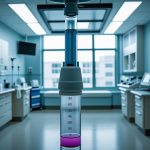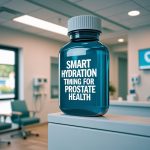Maintaining adequate hydration is fundamental to overall well-being, impacting everything from cognitive function and energy levels to physical performance and even mood. Yet, many people struggle with consistently drinking enough water throughout the day, often opting for large volumes at infrequent intervals. This ‘chugging’ method can overwhelm the body’s absorption capacity, leading to a feeling of bloat and frequent urination without necessarily achieving optimal hydration. A more effective approach is strategic fluid spacing – distributing your intake evenly over time. The key isn’t how much you drink in one go, but how consistently you hydrate throughout the day, allowing your body to efficiently absorb and utilize the fluids it needs.
This article will explore the art of spaced hydration: how to intelligently distribute your fluid intake without falling victim to dehydration or discomfort. We’ll delve into understanding absorption rates, identifying individual hydration needs, and practical strategies for incorporating consistent sipping into even the busiest lifestyles. It’s about shifting from reactive gulping to proactive, mindful hydration – a subtle change that can yield significant improvements in how you feel and function. Proper spacing isn’’t simply about avoiding discomfort; it’s about maximizing the benefits of every drop you consume.
Understanding Fluid Absorption & The Body’s Limits
The human body doesn’t absorb fluids instantaneously. There’s a complex process involving the gastrointestinal tract, osmosis, and ultimately, absorption into the bloodstream. The rate at which we can effectively utilize ingested fluids is surprisingly limited – generally estimated to be around 800-1000ml per hour for optimal absorption. Consuming significantly more than this in a short period overwhelms the system, leading to excess fluid being quickly excreted through urine rather than being utilized by the body. This explains why chugging large amounts of water doesn’t necessarily equate to better hydration; much of it is simply flushed out.
Think of your body like a sponge – it can only absorb so much at once before becoming saturated. Once that saturation point is reached, any additional fluid spills over. Spaced hydration mimics the steady dripping needed for full absorption, allowing the ‘sponge’ to constantly replenish and utilize the liquid effectively. Furthermore, factors such as electrolyte balance play a crucial role; water alone isn’t always enough. Electrolytes (sodium, potassium, magnesium) help regulate fluid distribution and enhance absorption, making them vital components of optimal hydration strategies. To understand more about maintaining proper mineral levels, consider exploring how to manage sugars in a urology-safe diet.
This also explains why feeling bloated after drinking a lot of water is common. Your kidneys are working overtime to process the excess fluid, leading to frequent trips to the bathroom but not necessarily improved cellular hydration. Focusing on smaller, more frequent sips allows for consistent absorption and minimizes this diuretic effect. Optimal hydration isn’t about volume; it’s about utilization.
Identifying Your Personal Hydration Needs
Hydration needs are highly individual, varying based on a multitude of factors. There is no one-size-fits-all answer to the question of ‘how much water should I drink?’ While the often-cited “eight glasses a day” serves as a starting point, it’s essential to personalize your intake based on your unique circumstances. Here are some key considerations:
- Activity Level: Individuals engaged in strenuous physical activity or spending time in hot environments will naturally require more fluids than those with sedentary lifestyles. Exercise increases sweat rate and fluid loss, necessitating increased replenishment.
- Climate: Hot and humid climates significantly increase perspiration, demanding higher fluid intake to counteract dehydration. Similarly, high altitudes can also lead to faster fluid loss through respiration.
- Diet: Certain foods contribute to hydration (fruits and vegetables with high water content), while others may have a diuretic effect (caffeine, alcohol). Dietary habits influence your overall fluid needs.
- Body Weight: Larger individuals generally require more fluids than smaller ones due to increased body mass and metabolic rate.
- Health Conditions: Certain medical conditions (kidney disease, heart failure) or medications can impact fluid balance and necessitate adjustments to hydration strategies; always consult a healthcare professional if you have underlying health concerns.
A useful method for gauging your personal needs is to monitor your urine color. Pale yellow indicates good hydration, while dark yellow suggests dehydration. Another indicator is thirst – it’s a sign that your body is already experiencing fluid loss. Aim to drink consistently throughout the day before feeling thirsty. If you are concerned about urinary health and staying hydrated without issues, review how to stay hydrated without triggering urgency.
Practical Strategies for Spaced Hydration
Implementing spaced hydration into your daily routine doesn’t require drastic changes; rather, it’s about incorporating small, consistent habits. Here are some effective strategies:
- Start Your Day with Water: Begin your morning with a glass of water before coffee or breakfast. This helps rehydrate the body after sleep and kickstarts metabolic processes.
- Carry a Reusable Water Bottle: Having a readily accessible water bottle serves as a constant reminder to sip throughout the day. Choose a size that encourages frequent refills without being overwhelming.
- Set Reminders: Utilize phone alarms or apps designed for hydration tracking. These reminders prompt you to take regular sips, even during busy periods.
- Pair Water with Activities: Associate water intake with daily activities – drink before, during, and after meals, while commuting, or during work breaks. This creates a natural rhythm of consistent hydration.
- Infuse Your Water: Add slices of fruit (lemon, cucumber, berries) or herbs (mint) to your water for enhanced flavor and enjoyment, encouraging greater intake.
- Don’t wait for thirst: Thirst is already an indicator that you are mildly dehydrated. Aim to sip consistently before you feel thirsty.
Consistent small sips are far more effective than infrequent large gulps. Experiment with different strategies to find what works best for your lifestyle and preferences. Remember, the goal isn’t just to drink a certain amount of water; it’s to ensure your body can effectively absorb and utilize those fluids for optimal health and well-being.
Electrolytes: The Hydration Boosters
While water is essential, electrolytes are the unsung heroes of hydration. These minerals – sodium, potassium, magnesium, chloride – play a critical role in maintaining fluid balance, nerve function, and muscle contractions. When you sweat, you lose both fluids and electrolytes. Replenishing these lost electrolytes is crucial for preventing dehydration and optimizing performance.
- Sodium: Helps regulate fluid levels and aids in absorption.
- Potassium: Essential for muscle function and maintaining proper cellular hydration.
- Magnesium: Involved in numerous bodily processes, including energy production and nerve transmission.
You can replenish electrolytes through various sources:
- Electrolyte Drinks: Commercial electrolyte beverages are available, but be mindful of added sugars and artificial ingredients. Look for options with low sugar content or consider making your own.
- Food Sources: Many foods naturally contain electrolytes. Bananas (potassium), spinach (magnesium), and pickles/salty snacks (sodium) can contribute to replenishment.
- Electrolyte Tablets/Powders: Convenient options that can be added to water for a quick electrolyte boost.
For everyday hydration, plain water is typically sufficient. However, during intense physical activity or in hot weather, incorporating electrolytes into your fluid intake becomes particularly important. Don’t underestimate the power of electrolytes – they are vital for maximizing hydration efficiency. To further support kidney health through dietary choices, consider foods to support kidney drainage without irritation.
Recognizing Dehydration & Avoiding Common Pitfalls
Despite best efforts, it’s possible to inadvertently become dehydrated. Being able to recognize the early signs is crucial for prompt intervention. Symptoms of mild dehydration include:
- Thirst
- Dry mouth and throat
- Dark yellow urine
- Headache
- Fatigue
- Dizziness
More severe dehydration can lead to:
- Extreme thirst
- Infrequent urination
- Muscle cramps
- Confusion
- Rapid heartbeat
Avoid common pitfalls that hinder hydration efforts:
- Relying solely on thirst: As mentioned earlier, thirst is a late indicator of dehydration. Drink consistently before feeling thirsty.
- Excessive caffeine or alcohol consumption: These substances have diuretic effects, increasing fluid loss. Counteract their dehydrating effects by drinking extra water.
- Ignoring environmental factors: Adjust your fluid intake based on climate and activity level.
- Overlooking the importance of electrolytes: Remember that simply drinking water isn’t always enough – electrolytes are essential for optimal hydration.
Hydration is a continuous process, not a one-time fix. By embracing spaced hydration strategies and staying attuned to your body’s needs, you can unlock the numerous benefits of consistent, efficient fluid replenishment. If you’re looking for ways to build sustainable habits around your fluid intake, consider how to build a urology-friendly meal routine.





















